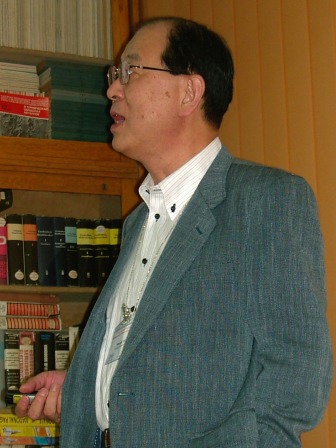|
|
New process for ULSI interconnection using activated SAM (self-assembled monolayer)
Tetsuya Osaka, Masahiro Yoshino
Department of Applied Chemistry School of Science and Engineering,
Waseda University 3-4-1 Okubo, Shinjuku-ku, Tokyo, Japan
E-mail: osakatets@waseda.jp
|

|
A novel fabrication process for ULSI interconnection using Pd activated Self-Assembled Monolayer (SAM)
and electrochemical deposition technique including both electro and electroless deposition has been proposed
[1-2]. Diffusion barrier layer that suppresses the Cu diffusion is a critical technique in the current
ULSI structures. High thermal stability, Cu diffusion resistance and film thinness are the properties
required for a reliable diffusion barrier layer. It has already been reported that NiB layer formed on
SAM treated substrate by electroless deposition is a candidate for the barrier layer materials [2-3]. However,
40 nm thickness of the NiB layer is needed to obtain the stable performance as a reliable diffusion barrier
layer. To realize an ultra thin diffusion barrier layer, the optimization of the surface conditions of SAM
modified substrate such as catalyst condition has been investigated. Adsorption and valency conditions of
catalyst “Pd” on the SAM and its effect on film morphology were discussed. An organic low-k dielectrics films
(Tokyo Ohka Kogyo Co. Ltd.,) modified by SAM of 3-aminopropyltriethoxy silane was used as a starting material.
Solution containing 5.5×10-5 mol/dm-3 PdCl2 and 1 ml/ dm-3 concentrated hydrochloric acid was used in catalyzation
process. To estimate the distribution and conditions of the catalyst, TEM (Transmission Electron Microscope) and
XPS (X-ray Photo-electron Spectroscopy) were used. The film surface, just after the catalyst process was confirmed
by XPS spectrum (Pd-3d5/2). The peak of the spectrum obtained from the specimen merely immersed into the catalyst
solution appeared near oxidized Pd area. The peak was shifted to peak of metallic Pd area by immersed into the
solution containing reducing agent. TEM measurement was used to estimate the distribution and morphology of Pd.
From the specimen after reduction, small metal particles (under 5 nm) were observed. Electron diffraction shows
that the particles were Pd metals. We believe the uniform particle size and location of Pd particles on the SAM
are important factors on the process to make thin films.
References
[1] T. Osaka et al., Electrochemical Society Proceedings, PV 2004-17, 251 (2004).
[2] M. Yoshino et al., Electrochimica Acta 51(5), 916-920 (2005).
[3] T. Osaka et al., Surface and Coating Technology 169-170, 124-127 (2003).
|
|